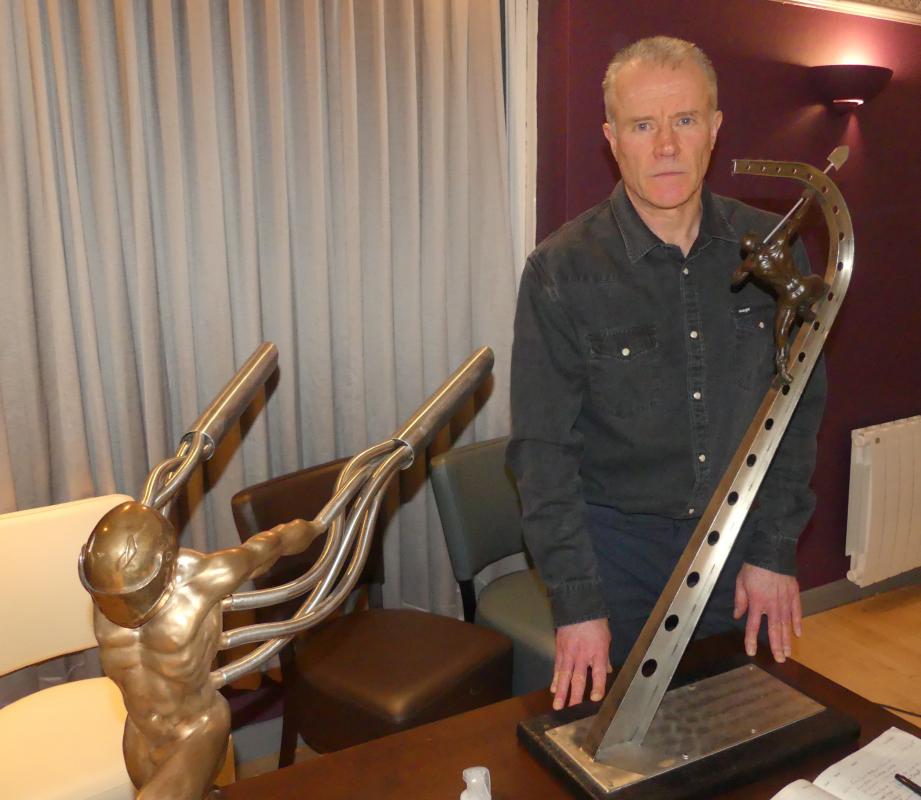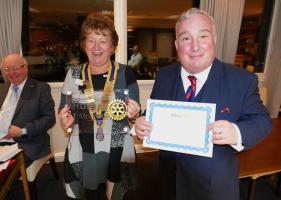Tom Marley - Sculptures
Tue, Nov 2nd 2021 at 5:45 pm - 7:45 pm
Tom Maley

ROBIN OF PEGSWOOD AT MORPETH ROTARY
Local sculptor Tom Maley turned a meeting of Morpeth Rotary into a magical gallery of skill and imagination when he brought examples of his work to illustrate a talk. It was a talk in two parts, one about his artistic work and one about the practicalities of putting up the Robin of Pegswood sculpture on the A197 in 2009.
Tom’s father Patrick had been a pit fitter at Lynemouth Colliery. He wanted his children to be fully aware of art, sport, music and culture. His dad made models in clay, had an interest in engineering, fixed cars and told him stories of the industrial north. Tom watched and helped his dad so even before school had learnt to weld, made full use of a plastic ‘Meccano’ set and was fascinated with engines. He left school at 16, where he had been good at art, sport and technical drawing, as he wanted to make his way in the world. He went to Ashington Technical College and completed a five year engineering apprenticeship with Welwyn Electronics learning about draughting and design. Tom visited art exhibitions and taught himself to sculpt. He began with slate carving and in 1996 made an 8’ high statue of Jackie Milburn that was put on display at Woodhorn. It was covered in the press and got good reviews. Sir John Hall, Chairman at Newcastle United, heard about it and invited him to St. James Park. The statue was shown there until 1999. In 2000, footballer Wilf Mannion of Middlesbrough died. Club members had seen the Milburn statue and offered Tom his first commission, to prepare a 9’ bronze statue. One of his earliest creations from 1988 had been of Icarus who had learnt a sharp lesson about flying and returned with a V8 engine to give him power. He has made a number of versions of Electra and Icarus. Ellington Colliery has a memorial he made of a miner next to a pit winding wheel. He made ‘Catfish’ a version of the Singapore ‘Merlion’ giving it the more dynamic body of a macro-shark, the head of a lion and a V8 engine. It is on display at Cambois near the Alcan plant. One of his Icarus statues is in Florida, bought by a Harley Davidson dealer. He made one of Siamese thugs ‘Fred and Doug’ conjoined at the beer belly with one wearing the black and white of Newcastle United and one wearing the red and white of Sunderland. He has a 5 metre high globe made out of real rail-track rails at Furnace Bank in Bedlington. He modelled the ‘Hog’ for Harley Davidson, based on the slang term for their bikes, as a warthog who thinks he is a motorbike. He has produced a tribute to the greatly admired Sir Charles Parsons and his steam turbine that he will take to the Discovery Museum at Newcastle. He made ‘Horse Power’ a seahorse with a steam turbine and exhausts in its tail. He has one of the Minotaur escaping the Labyrinth called the Liberotaur. He made one of Locomotive Number 1 at Stockton as built by George Stephenson, using rails originally made at Bedlington. There are many of his works across the world and in the north east.
His largest work is ‘Robin of Pegswood’ with a miner as a Greek hero, cast by Black Isle Bronze of Inverness. He is on a 36’ high girder and firing his shovel at a coal seam. It was commissioned in 2007 by Charles Sample, Land Agent for Welbeck Estates at Bothal, and was placed on a new roundabout on the Pegswood Bypass. Charles gave the work its name. There is a link with Robin Hood as the main part of the Welbeck Estates is in Nottinghamshire. Tom went into detail about how it was done. As always it started with imagination, ideas and sketches. He made a small model then took a month to make a rough scale model called a maquette, then a 3’ high workshop model that took 2-3 weeks. This was used to engage with the village, Northumberland County Council and the local council and to apply for planning permission. It got 95% positive ratings. The head was modelled separately. The technical engineering side took as long as the artistic modelling side. It was done in box sections with timber to support the clay and clad with polystyrene. The clay was worked down to get the shape. It was the biggest model he had done in clay and 1.5 tons were used. It had to be supported with a metal framework. It needed 3” of plaster on the clay model which four people had to mix and pour and spoon on by hand and reinforce. It took up to to 2 tons of plaster. The sculpting, as usual, was a big mess of dust and mud. The next process was to separate the plaster from the clay and make a positive cast in fibreglass. The mold had to be smashed to release the fibreglass which then had to be cleaned and repaired. Casting took two weeks with another two weeks to put it all together. It was driven to Inverness where another set of molds were made using sand casting. It produced a 6 metre bronze that needed to be TIG welded together. It was driven back to Ashington to join the girder, made at North Seaton, then all welded together and put up on a 45 ton steel reinforced concrete base on top of a steel frame welded onto a subframe with boxplate and bolts. Tom finished by talking of humorous and imaginative sculptures he had yet to create. The vote of thanks was by Gordon Bolton.
